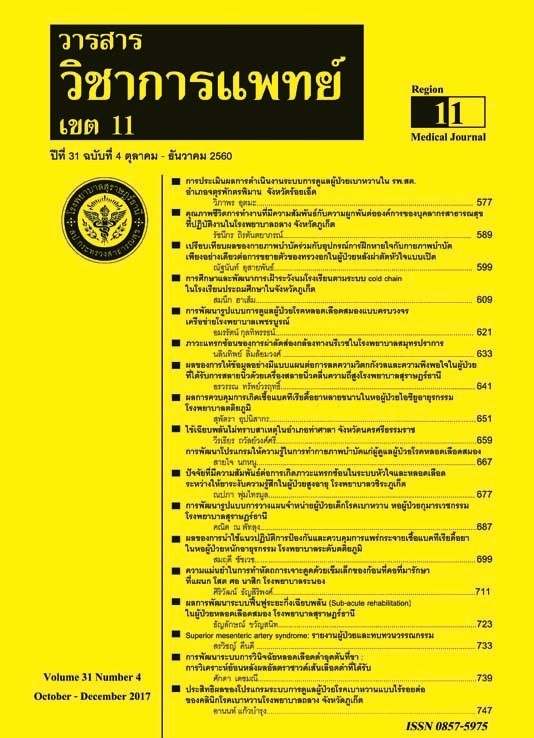The outcome of control the bacterial multidrug-resistant in medical ICU, tertiary hospital.
Keywords:
multidrug-resistant bacterial, Medical ICUAbstract
Multidrug-resistant bacterial in hospital. Is a major problem and is likely to increase. This study is a descriptive study. This was prospective study to investigate the incidence of multidrug-resistant bacterial inpatients in the hospital following multidrug-resistant bacterial management In the ICU ward Between 2015 January – 2016 December, 1,957 patients were prescribed multidrug-resistant bacterial management guidelines based on empirical evidence leading to their practice. The guideline including 1) patient identification 2) environmental management 3) knowledge of staff 4) knowledge of patients and relatives and e) hand washing. The compliance of guideline showed that 91.68%, 91.60%, 91.31% and 92.86, respectively. The study indicated that after multidrug-resistant bacterial management guidelines were applied, many patients with recurrent antimicrobial resistance were 2.85%.
References
2. Mishra MP, Debata NK, Padhy RN. Surveillance of multidrug resistant uropathogenic bacteria in hospitalized patients in Indian. Asian Pac J Trop Biomed; 2013;3(4):315-24.
3. Morales E, Cots F, Sala M, Comas M, Belvis F, Riu M, et al. Hospital costs of nosocomial multi-drug resistant Pseudomonas aeruginosa acquisition. BMC Health Serv Res; 2012;23:12-122.
4. Nemeth J, Ledergerber B, Preiswerk B, Nobile A, Karrer S, Ruef C, et al. Multidrug-resistant bacteria in travellers hospitalized abroad: prevalence, characteristics, and influence on clinical outcome. J Hosp Infect; 2012;82(4):254-9.
5. Jariyasethpong T, Tribuddharat C, Dejsirilert S, Kerdsin A, Tishyadhigama P, Rahule S, et al. MRSA carriage in a tertiary government hospital in Thailands: emphasis on prevalence and molecular epidemiology. Eur J Clin Microbiol Infect Dis; 2010;29:977–85.
6. Tyagi A, Kapil A, Singh P. Incidence of methicillin resistant Staphylococcus aureus (MRSA) in pus samples at a tertiary care hospital. J Indian Acad Clin Med; 2008;9:33–5.
7. Jamulitrat S, Arunpan P, Phainuphong P. Attributable mortality of imipenem-resistant nosocomial Acinetobacter baumannii blood stream infection. J Med Assoc Thailand; 2009;92:413–9.
8. Eagye KJ, Kuti JL, Nicolau DP. Risk factors and outcomes associated with isolation of meropenem high-level-resistant Pseudomonas aeruginosa. Infect Control Hosp Epidemiol; 2009;30(8):746-52.
9. Grgurich PE, Hudcova J, Lei Y. Management and prevention of ventilator-associated pneumonia caused by multidrug-resistant pathogens. Expert Rev Respir Med; 2012;6(5):533-55.
10. Landelle C, Marimuthu K, Harbarth S. Infection control measures to decrease the burden of antimicrobial resistance in the critical care setting. Curr Opin Crit Care; 2014 ;20(5):499-506.
11. Chung HC, Lee RP. Multidrug-resistant bacteria in the hospital: the focus of nursing care. Hu Li Za Zhi; 2011; 58(4):11-5.
12. Ghirardi B, Pietrasanta C, Ciuffini F, Manca MF, Uccella S, Lavizzari A, et al. Management of outbreaks of nosocomial pathogens in neonatal intensive care unit. Pediatr Med Chir; 2013;35(6):263-8.
13. Vattanavanit V, Chayakul P. Acinetobacter infections in the intensive care unit. Songkla Med J ; 2013;31(2):91-100.
14. วิไล ลีสุวรรณ, รุจิเรศ ธนูรักษ์, ยุวดี ฦาชา. เทคนิคการสร้างเครื่องมือวิจัย และวิธีการเก็บรวบรวมข้อมูล. ใน ยุวดี ฦาชา และคณะ (บรรณาธิการ), วิจัยทางการพยาบาล (พิมพ์ครั้งที่ 7). กรุงเทพ: มหาวิทยาลัยมหิดล; 2543: 86-140.
15. ปิยะฉัตร วิเศษศิริ, อะเคื้อ อุณหเลขกะ, นงเยาว์ เกษตร์ภิบาล. การพัฒนารูปแบบการส่งเสริมการปฏิบัติการป้องกันการติดเชื้อดื้อยาของบุคลากรพยาบาล แผนกอายุรกรรมโรงพยาบาลระดับตติยภูมิ พยาบาลสาร; 2558;42(3) :119-134.
16. นฤมล จุ้ยเล็ก, วิลาวัณย์ พิเชียรเสถียร, นงเยาว์ เกษตร์ภิบาล. การพัฒนาระบบการให้คะแนนปัจจัยเสี่ยงของการติดเชื้อดื้อยาหลายกลุ่มสำหรับผู้ป่วยใน.พยาบาลสาร;2559 ;43(3):69-80.
17. O’Horo JC, Silva GL, Munoz-Price LS, Safdar N. The efficacy of daily bathing with chlorhexidine for reducing healthcare-associated bloodstream infections: a meta-analysis. Infect Control Hosp Epidemiol; 2012;33(3):257-67.
18. Huskins WC, Huckabee CM, O’Grady NP. Intervention to reduce transmission of resistant bacteria in intensive care. N Engl J Med; 2011;364(15):1407-18.






